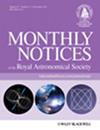稳定的质量转移和恒星风对引力波源形成的重要性
IF 4.8
3区 物理与天体物理
Q1 ASTRONOMY & ASTROPHYSICS
引用次数: 0
摘要
大量引力波(GW)探测揭示了并合黑洞双星群的特性,但这类系统是如何形成的仍存在很大争议。了解恒星物理学对可观测到的引力波群体的影响,将有助于我们了解如何利用引力波数据和其他观测数据来约束人们对大质量双星演化的不甚了解。我们利用种群合成代码 SeBa 对经典孤立双星形成通道进行了参数研究,以调查凝聚双黑洞种群的特性对质量转移第一阶段和恒星风相关不确定性的敏感程度。我们改变了五个假设:1和2)质量转移第一阶段的质量转移效率和角动量损失;3)具有辐射包层的巨型供体的质量转移稳定性标准;4)演化恒星形成深对流包层时的有效温度;5)恒星风的质量损失率。我们发现,目前与质量转移第一阶段有关的不确定性对不同主导通道的相对重要性有巨大影响,而全球变暖源的可观测人口统计则没有受到显著影响。我们所改变的参数对 GW 源的群体特性有着复杂而又相互关联的影响。因此,鉴于我们目前的模型存在很大的不确定性,仅从 GW 数据推断大质量双星物理学仍然极具挑战性。本文章由计算机程序翻译,如有差异,请以英文原文为准。
Importance of stable mass transfer and stellar winds for the formation of gravitational wave sources
The large number of gravitational wave (GW) detections have revealed the properties of the merging black hole binary population, but how such systems are formed is still heavily debated. Understanding the imprint of stellar physics on the observable GW population will shed light on how we can use the gravitational wave data, along with other observations, to constrain the poorly understood evolution of massive binaries. We perform a parameter study on the classical isolated binary formation channel with the population synthesis code SeBa to investigate how sensitive the properties of the coalescing binary black hole population are on the uncertainties related to first phase of mass transfer and stellar winds. We vary five assumptions: 1 and 2) the mass transfer efficiency and the angular momentum loss during the first mass transfer phase, 3) the mass transfer stability criteria for giant donors with radiative envelopes, 4) the effective temperature at which an evolved star develops a deep convective envelope, and 5) the mass loss rates of stellar winds. We find that current uncertainties related to first phase of mass transfer have a huge impact on the relative importance of different dominant channels, while the observable demographics of GW sources are not significantly affected. Our varied parameters have a complex, interrelated effect on the population properties of GW sources. Therefore, inference of massive binary physics from GW data alone remains extremely challenging, given the large uncertainties in our current models.
求助全文
通过发布文献求助,成功后即可免费获取论文全文。
去求助
来源期刊

Monthly Notices of the Royal Astronomical Society
ASTRONOMY & ASTROPHYSICS-
CiteScore
9.10
自引率
37.50%
发文量
3198
审稿时长
3 months
期刊介绍:
Monthly Notices of the Royal Astronomical Society is one of the world''s leading primary research journals in astronomy and astrophysics, as well as one of the longest established. It publishes the results of original research in positional and dynamical astronomy, astrophysics, radio astronomy, cosmology, space research and the design of astronomical instruments.
 求助内容:
求助内容: 应助结果提醒方式:
应助结果提醒方式:


